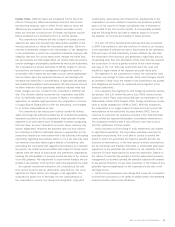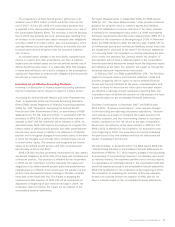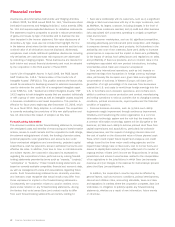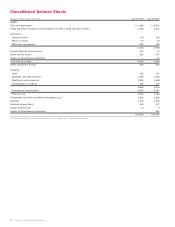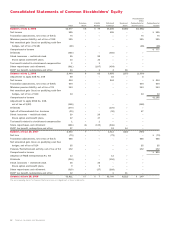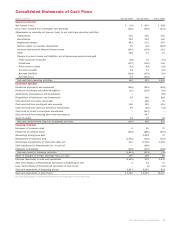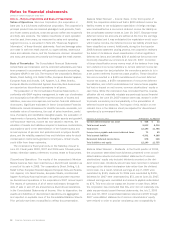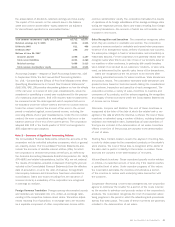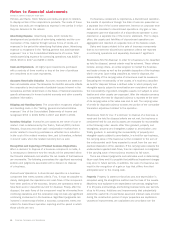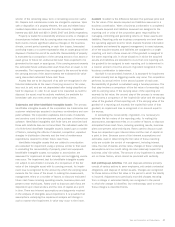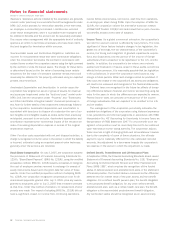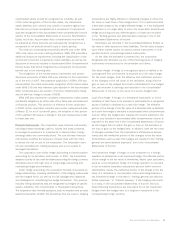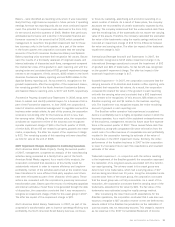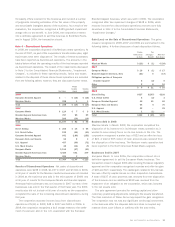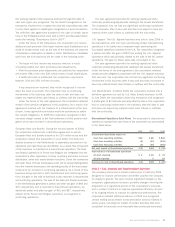Sara Lee 2008 Annual Report Download - page 47
Download and view the complete annual report
Please find page 47 of the 2008 Sara Lee annual report below. You can navigate through the pages in the report by either clicking on the pages listed below, or by using the keyword search tool below to find specific information within the annual report.
the presentation of dividends, retained earnings and total equity.
The impact of this revision on the relevant lines in the balance
sheet and common stockholders’ equity statement (as adjusted
for discontinued operations) is summarized below:
As Reported As Adjusted
Total common stockholders’ equity July 2, 2005 $2,732 $2,577
Retained earnings July 2, 2005 4,361 4,206
Dividends 2006 611 456
Dividends 2007 298 370
Balance at June 30, 2007
Accounts payable 1,055 1,127
Total current liabilities 4,301 4,388
Retained earnings 3,485 3,413
Total common stockholders’ equity 2,615 2,543
Accounting Changes – Adoption of Staff Accounting Bulletin No. 108
In September 2006, the SEC issued Staff Accounting Bulletin
No. 108, “Considering the Effects of Prior Year Misstatements When
Quantifying Misstatements in Current Year Financial Statements”
(SAB 108). SAB 108 provides interpretive guidance on how the effects
of the carryover or reversal of prior year misstatements should be
considered in quantifying a current year misstatement for the purpose
of a materiality assessment. SAB 108 requires that misstatements
be measured under the dual approach which requires that errors
be evaluated under the rollover method and the iron curtain method.
Under the rollover method, the amount of the error in the current
period is evaluated against current period income, including the
reversing effects of prior year misstatements. Under the iron curtain
method, the error is quantified by evaluating the total error in the
balance sheet as of the end of the current period. The corporation
adopted SAB 108 in the fourth quarter of 2007 and recognized a
$58 adjustment upon adoption.
Note 2 – Summary of Significant Accounting Policies
The Consolidated Financial Statements include the accounts of the
corporation and its controlled subsidiary companies, which in general
are majority owned. The Consolidated Financial Statements also
include the accounts of variable interest entities (VIEs) for which
the corporation is deemed the primary beneficiary, as defined by
the Financial Accounting Standards Board’s Interpretation No. 46(R)
(FIN 46(R)) and related interpretations, but the VIEs are not material.
The results of companies acquired or disposed of during the year are
included in the Consolidated Financial Statements from the effective
date of acquisition, or up to the date of disposal. All significant
intercompany balances and transactions have been eliminated in
consolidation. Gains and losses resulting from the issuance of
common stock by a subsidiary of the corporation are recognized
in earnings as realized.
Foreign Currency Translation Foreign-currency-denominated assets
and liabilities are translated into U.S. dollars at exchange rates
existing at the respective balance sheet dates. Translation adjust-
ments resulting from fluctuations in exchange rates are recorded
as a separate component of other comprehensive income within
common stockholders’ equity. The corporation translates the results
of operations of its foreign subsidiaries at the average exchange rates
during the respective periods. Gains and losses resulting from foreign
currency transactions, the amounts of which are not material, are
included in net income.
Sales Recognition and Incentives The corporation recognizes sales
when they are realized or realizable and earned. The corporation
considers revenue realized or realizable and earned when persuasive
evidence of an arrangement exists, delivery of products has occurred,
the sales price charged is fixed or determinable, and collectibility is
reasonably assured. For the corporation, this generally means that we
recognize sales when title to and risk of loss of our products pass to
our resellers or other customers. In particular, title usually transfers
upon receipt of our product at our customers’ locations, or upon ship-
ment, as determined by the specific sales terms of the transactions.
Sales are recognized as the net amount to be received after
deducting estimated amounts for sales incentives, trade allowances
and product returns. The corporation estimates trade allowances and
product returns based on historical results taking into consideration
the customer, transaction and specifics of each arrangement. The
corporation provides a variety of sales incentives to resellers and
consumers of its products, and the policies regarding the recognition
and display of these incentives within the Consolidated Statements
of Income are as follows:
Discounts, Coupons and Rebates
The cost of these incentives is
recognized at the later of the date at which the related sale is rec-
ognized or the date at which the incentive is offered. The cost of these
incentives is estimated using a number of factors, including historical
utilization and redemption rates. Substantially all cash incentives of
this type are included in the determination of net sales. Incentives
offered in the form of free product are included in the determination
of cost of sales.
Slotting Fees
Certain retailers require the payment of slotting fees
in order to obtain space for the corporation’s products on the retailer’s
store shelves. The cost of these fees is recognized at the earlier of
the date cash is paid or a liability to the retailer is created. These
amounts are included in the determination of net sales.
Volume-Based Incentives
These incentives typically involve rebates
or refunds of a specified amount of cash only if the reseller reaches
a specified level of sales. Under incentive programs of this nature,
the corporation estimates the incentive and allocates a portion
of the incentive to reduce each underlying sales transaction with
the customer.
Cooperative Advertising
Under these arrangements, the corporation
agrees to reimburse the reseller for a portion of the costs incurred
by the reseller to advertise and promote certain of the corporation’s
products. The corporation recognizes the cost of cooperative adver-
tising programs in the period in which the advertising and promotional
activity first takes place. The costs of these incentives are generally
included in the determination of net sales.
Sara Lee Corporation and Subsidiaries 45


